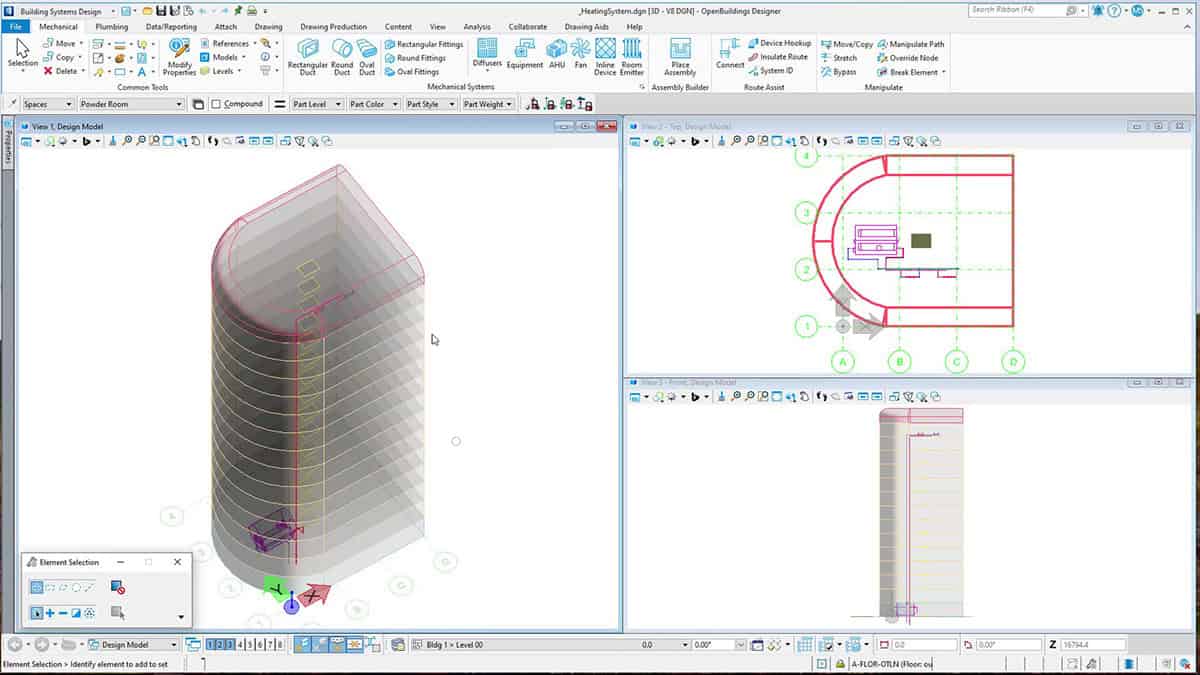AEC professionals frequently encounter complex geometry or size obstacles during the conceptual and design phases of building design projects. Computational design is a method that can help architects and engineers overcome these obstacles. It’s a fast, efficient, and effective method of automating tasks and exploring multiple design options. In computational design, designers can automatically propagate changes without needing to recreate the entire model manually, enabling them to power through repetitive changes, explore alternatives, and ultimately make more informed decisions.
As a result, they can spend more time designing and solving problems and less time illustrating and documenting those solutions. Computational design also plays a crucial role in helping AEC professionals rightsize their teams and develop new planning approaches, which leads to enhanced efficiency.
Better Design with OpenBuildings GenerativeComponents
OpenBuildings GenerativeComponents is the computational design capability of OpenBuildings Designer, the all-in-one building design and energy analysis software developed by Bentley Systems. It was first introduced in 2003 as GenerativeComponents (GC), Bentley’s standalone computational design software, and was commercially released in November 2007 after an extended evaluation phase with a group of international users. Today, OpenBuildings GenerativeComponents represents a workbench for design professionals to build tools to examine, explore, automate, and refine answers to basic as well as complex design questions.
It supports dynamic modeling and directly manipulating geometry, applies rules and captures relationships among model elements, and defines simple geometry or complex forms and systems through precisely described codes and algorithms.
OpenBuildings GenerativeComponents supports many industry-standard file inputs and outputs, including native Excel, DGN, DWG, IFC, and more. Architects and engineers primarily use this tool to develop new processes and efficient workflows while designing complex buildings.
AEC Professionals use OpenBuildings GenerativeComponents’ Computational Design advances
Among many other benefits, architects and engineers can:
- Quickly work through a range of “what-if” alternatives, even for highly complex buildings
- Explore many more options in less time, efficiently creating and managing even complex geometries
- Automate design processes to speed up design iterations
- Create free forms for designs and idea spaces that were previously unimaginable
- Take advantage of computer-aided models to save time by simply changing the model instead of completely rebuilding it manually
OpenBuildings GenerativeComponents broaden Technical Possibilities
- Users can create and manage complex geometric relationships by efficiently controlling parametric object properties and relationships between objects. Also, it’s possible to compare alternative building shapes without manually creating detailed design models for each scenario.
- By facilitating rapid review of multiple designs, architects and engineers can quickly explore new design possibilities and investigate a comprehensive set of different “what-if” alternatives. AEC professionals can benefit from the freedom to model projects of any shape, size, and complexity without constraints.
- AEC professionals will be able to gain feedback on building materials, support structures, system performance, and environmental conditions, plus create designs that enable accurate and efficient processing through detailed production and fabrication.
Generative Design helps deliver Australia’s largest Sustainable Tower
Johnson Pilton Walker (JPW), a mid-sized architecture firm in Australia provides one of the best examples of a major project in which OpenBuildings GenerativeComponents played a significant role in the design process. JPW designed a building that, when completed, will be the largest building in the country. In the process, the firm has advanced the use of computational design with BIM using Bentley’s OpenBuildings Designer GenerativeComponents. It enabled JPW to completely change how the studio thought about the practice — spending more time designing and solving problems and less time representing and documenting those solutions.
Image: Courtesy of Johnson Pilton Walker
While many large and well-known firms use AAD (algorithm-assisted design) or “computer-aided design,” most lack the understanding of how to formulate ways to create scripts that support production and address quality control issues.
JPW’s utilized a script that established a polygonal grid, the envelope encompassing the building, where each polygon represented a panel in the facade system. They then created an Excel spreadsheet that tied back to the GC scripts controlling the polygonal grid.
It turned out that the panels were a typology of parts, with different dimensions of elements and the omission or addition of elements. These panel types were not modeled traditionally but were generated via scripting. “That’s how I learned the GC software,” says Sarah from JPW, who studied Grasshopper from McNeel at the university. “It took me a week to do the first draft. Then I could take the script and modify it for the second one, which took me a day. And the next one took me an hour.” That swift learning curve speaks to the power of iteration and automation through algorithms. For their efforts, the company was named a finalist in the 2019 Bentley Infrastructure Awards worldwide in the Buildings and Campuses category for its outstanding work with computer-aided design at 6 & 8 Parramatta Square.
Embrace the Power of Generative Design with OpenBuildings GenerativeComponents
Technology like BIM is the first step in improving the technological state-of-the-art of the AEC industry over earlier CAD technology. However, it can go even further with the application of a computational design capability like OpenBuildings GenerativeComponents.
Computational design is the transformation of computational principles to the design process. While a designer typically relies on experience to create a design, computational design aims to improve the planning process by capturing the design decisions in a computer language.
OpenBuildings GenerativeComponents defines the relationships between elements and not just the elements themselves, and those are relationships that AEC professionals understand. BIM simply targets elements including their properties. With OpenBuildings GenerativeComponents, architects and engineers can define how these elements relate to each another, their “cause-and-effect” dependencies, and the “rules” that govern them, which allows a change in one element to be propagated to the entire design.
Users can also iterate more easily, try various “what-if” scenarios to explore more solutions than they would have the time and the resources to do, and ultimately automate many day-to-day processes. In conclusion, using computational design with the help of OpenBuildings GenerativeComponents lifts BIM projects to another level.
Interested in a no-risk, free trial of OpenBuildings Designer? Click on the button below:








